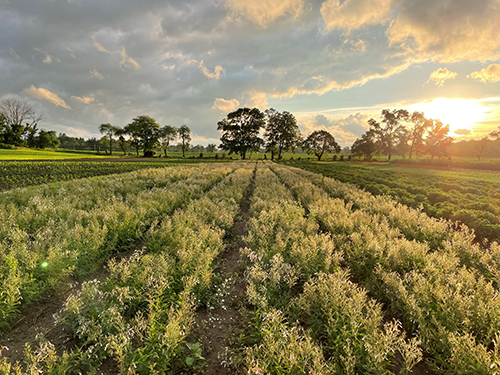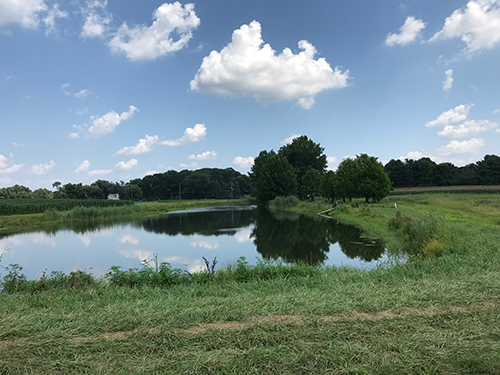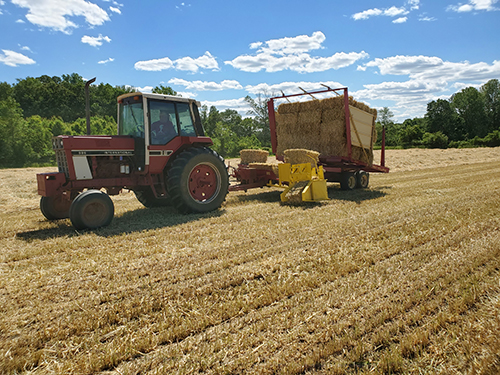
Fact Sheet FS1342
Before starting any new farming endeavor, it is important to conduct a site analysis to take inventory of the physical characteristics and resources that exist on the land. This fact sheet is intended to help you identify the strengths and weaknesses of a specific parcel of land under consideration for commercial agricultural production. By conducting a proper site analysis, you can help to ensure the security of your investment.
Farm Goals
It is important to select farmland that matches the goals of your farm plan. In your plan, list the products you wish to produce, then determine if the site conditions meet the criteria for your business. Consider the types of crops, products, and services you plan to offer and the resources you will need to support your farming endeavor. Make certain that the soils, water, and buildings on the site will support your farm plan.
For example, if you plan to run an agritourism or pick-your-own operation on the farm, you will need adequate growing space, ample parking, and safe travel routes to limit risks and injuries. A farm that is divided by unsafe roads may make travel unnecessarily risky for your agritourism rides.
Location/Aesthetics
The location of your farm and the aesthetics of the surroundings can be extremely important for the success of your farm. Farms that are easily accessible and visible to the public can greatly expand marketing opportunities. The overall aesthetics of the farm can greatly enhance the positive experience for visitors to your market or agritourism business.
Zoning
You will need to research local zoning ordinances to be sure the area is zoned for agricultural production and/or that your municipality allows the production of crops or animals at the site. Check with the local township to determine which permits and approvals are needed before moving forward with your business. Check with the local Cooperative Extension office or the township to determine if the land was recently farmland assessed and if there was a recent water certification for the property. Determine if there are any restrictions to selling your products at the site.
Leasing Farmland
Leasing farmland can provide a cost-effective option for beginning an agricultural business. However, consider that the establishment costs for high-value crops (e.g. apples) can be $10,000 per acre or more. A secure, long-term lease of 10 years or more would be required to return your investment and make a profit. If you are growing grain crops, the cost per acre for lease or purchase should be as low as possible because the returns per acre are often lower than other high value crops. Make sure to secure all agreements in writing before you invest in any property. Spell out clearly what you plan to grow, what improvements you will make, and if you will be selling directly from the property to customers. Avoid annual leases unless you are growing low value crops. You may wish to consult with a legal expert before entering into a land use lease or agreement.
Land Use History
Understanding a field’s history can also help you to make an informed decision about its suitability to your farming needs.
It is possible that soil may be contaminated with toxic compounds or heavy metals, such as cadmium, arsenic, lead, or mercury. If you suspect that the land may have a contamination issue, it is important to test the soil for toxicity before proceeding to grow a crop. Learn about the previous field history and if, during testing, toxic levels of any contaminants are found, a remediation plan will be required before any farming can occur.
Soil Characteristics
Soil characteristics will have a major influence on crop growth and the suitability of a specific parcel for certain agricultural practices. While some soils may support thriving vegetable fields, other soils are better suited to pastures supporting livestock or equine operations, nursery and Christmas tree production, or woodlots. The NRCS Web Soil Survey allows you to assess various soil characteristics for a specific location, which can help you in the selection process.
Soils that are primarily sand or heavy clay represent the extremes in soil types and may be more difficult to improve and grow certain crops at the desired or sustainable production level needed to support the farm. Loam soils contain more than one type of soil particle and can retain more nutrients while providing better drainage for crops.
Topsoil is very important for any farming operation, as the bulk of soil fertility and biological activity resides in this soil layer. As such, the field site should be evaluated for any signs of current or previous erosion resulting in the loss of topsoil. Furthermore, consider whether there are any areas that look like they might be susceptible to erosion in the future due to steep slopes or lack of adequate ground covers.
Soil Fertility
Though soil fertility can be modified to an extent, a comprehensive understanding of the existing soil fertility of a site may help you determine how much you will have to invest in soil amendments to optimize fertility conditions for agricultural use.
To determine the soil pH and levels of nutrients and organic matter already present before adding any fertilizers or liming materials, it is important to take a soil fertility test. This is the most accurate way to evaluate the nutritional needs of the soil. The Rutgers Soil Testing Laboratory provides testing services for farmers and can identify and provide recommendations to remediate any fertility issues. Your local county agricultural agent can help you to interpret these test results. Soil tests can help you determine the suitability of the site for specific crops and help determine the amount of inputs needed to optimize production.
If bio-solids were used in the past, test the soil to determine if there are any heavy metals that may be of concern for leafy greens or other crops that may absorb these compounds into the edible portions of the plant.
Keep in mind that adequate modifications could take two to three years when starting with low fertility soils or if the pH requires major modifications.
Slope
Soils with steep slopes are more prone to erosion. This can result in the loss of topsoil, fertilizer, and chemicals, thus reducing the long-term fertility of the soil and potentially causing pollution in surrounding areas. Sloping fields may be more suitable to certain types of agriculture that have a permanent cover, such as hayfields, pastures, or orchards. With annual crop production, the soil is continuously disturbed so there is a less developed root system to stabilize the soil. No-till methods can help to reduce erosion in these situations, as can orienting the beds perpendicular to the slope of the land so they act as swales to catch rainwater and potential runoff. Steep slopes may also prove more challenging for overall management and may present dangers to equipment operators on the farm. Tractors or sprayers on the side of a slope can tip over more easily if dips or holes are encountered in the field from groundhogs or from soil erosion and depressions. While sloped fields can serve as pasture for livestock, make sure to never locate produce downhill from these pastures. Animal waste contains dangerous pathogens that can easily be washed down into produce fields by flowing water, causing contamination.
Aspect
Another element to note is the direction the fields are facing, or the aspect of the fields. Southern aspect will generally receive the most sunlight. However, proximity to trees or other structures can also influence the amount of sun that is reaching the crops. There may be spaces on the property that receive more hours of direct sunlight than others. Evaluate the site to determine if tree removal or other modifications are warranted to improve the amount of sunlight for the crops that you are planning to grow. Areas that receive less sunlight are also more likely to stay wetter and colder, especially in the springtime, lessening your growing season and production capacity.
Airflow
Airflow in a field can impact crops and soil, and therefore should be evaluated before starting to farm. Reduced airflow due to surrounding vegetation, structures, or low-lying sections of the field can cause moisture to remain in place and enhance the potential for disease problems. If this is the case, modifications may be needed to remove the obstructions and encourage air movement. However, an exposed and unprotected field may be subject to too much airflow, resulting in wind damage to crops and wind erosion of the soil. These situations may require the construction of a wind break and/or permanent soil cover to reduce erosion.
Irrigation
Evaluating the water sources on the farm will provide an indication of the capacity of the land to provide water for plants and/or animals. There may be ponds or streams that can provide adequate water for your needs, or there may be existing wells on site. Find out how many gallons per minute can be pumped from these wells and whether the well casings need repair. Knowing what kind of irrigation systems you plan on using will also help to determine your water requirements. Drip irrigation systems are typically more efficient and use less water than overhead irrigation systems. Also, note the location or potential location of all water sources and their proximity to the fields in which the water will be applied. In New Jersey, an Agricultural Water Use Certification or Registration may be required from the Department of Environmental Protection depending on the amount of water that you are planning to use.
Water used for irrigation should be free of contaminants. The NJDEP has a listing of labs certified to conduct drinking water tests.
The Rutgers On-Farm Food Safety website also includes a map listing of labs certified and capable of doing irrigation water microbiological testing that complies with federal regulations.
Flooding Potential
Another important aspect related to water on the farm that should be evaluated is whether the property is in a flood zone The depth to the water table will further influence the moisture status of a field, such that land with a shallow water table is prone to remaining wetter for longer periods of time. Thus, it is important to evaluate the water characteristics of a field before investing in a crop and to avoid flood prone or overly wet fields for production.
Wildlife
Wildlife, including deer, geese, and rodents can cause significant damage to crops, resulting in losses to the grower. The population of deer in many areas of New Jersey is 5 to 10 times the normal carrying capacity of the land. Deer can decimate your entire crop, and if you are growing vegetables, fecal matter from wildlife presents a contamination concern. A complete site evaluation should include an estimation of the severity of anticipated wildlife pressure. Fields that are near natural wooded areas that provide wildlife habitat may experience higher degrees of wildlife pressure. Certain crops are also more prone to damage by wildlife. For example, if you are planning to grow a crop that is preferred by deer, such as pumpkins, and your field is across the street from a wildlife reserve, you may want to consider installing protective fencing and including the cost of this infrastructure in your farm plan. Many growers are now erecting 8 to 10-foot permanent deer fencing around key production areas. Permanent fencing can range in cost from $6 to $12 dollars per linear foot. Electric fencing can often be installed for between $1 and $2 per linear foot.
Additional information on protecting your crops from wildlife damage can be obtained from this fact sheet:
Parking and Facilities
If you plan on having a farm stand or pick-your-own operation on the site, you will need to provide parking areas for customers. Your parking needs may be more extensive if you plan to conduct agritourism activities. If the site lacks convenient space for parking or has limited accessibility for cars, it may not be the right space for these types of operations. If you plan to add additional farm structures, be sure that you will be permitted to build what you will need to run your business. Structures may include greenhouses, high tunnels, housing for animals, packing sheds or processing areas, coolers, labor housing, and storage for equipment, tools, pesticides, fertilizers, and seed. Check with the local municipality to see what is allowed on the site. If all or part of the site is deed-restricted as part of the State Farmland Preservation Program there will be additional restrictions on what structures can be built and where on the site they can be located. You will need to be aware of any local or state impervious cover restrictions on the site before paving or building any new structures. While these may all not be needed at the onset of your farming operation, they may limit your expansion in the future if not taken into consideration earlier on.
Movement of Farm Equipment
Make certain that farm equipment can safely be transported to all areas of the farm where it is needed. Consolidating farm operations that require the movement of equipment will shorten transport distances and help to save time and fuel costs. Evaluate existing driveways and farm roads to see if they are adequate for your needs. If not, they may need to be graded or new roads may need to be developed. If you are planning to offer educational tours or agritourism on your farm, there should be a safe, flat route for these activities that avoids having to cross busy roads or risky areas.
Learn from Successful Farmers and Other Professionals
It may be wise to visit farms that are already conducting the type of business that you want to run and observe the layout and operations of their farm. Reach out to discuss your business plans with agricultural professionals at cooperative extension, Farm Service Agency or the Natural Resource Conservation Service. Join agricultural organizations and connect with successful farmers who may share advice for your farm business and guidance on site requirements for your future farm operation.
Starting to farm on a new site is an exciting and challenging proposition. Though there are many aspects to consider, time taken for proper site evaluation and careful planning will be rewarded as you work toward developing a successful agricultural endeavor.
References and Resources
- Rutgers NJAES Beginner Farmer Training Program
- NRCS Web Soil Survey
- Rutgers Soil Testing Laboratory
- NJ Department of Environmental Protection: Agricultural, Aquacultural, and Horticultural Water Use Certifications & Registrations
June 2022
Copyright © 2025 Rutgers, The State University of New Jersey. All rights reserved.
For more information: njaes.rutgers.edu.
Cooperating Agencies: Rutgers, The State University of New Jersey, U.S. Department of Agriculture, and Boards of County Commissioners. Rutgers Cooperative Extension, a unit of the Rutgers New Jersey Agricultural Experiment Station, is an equal opportunity program provider and employer.



